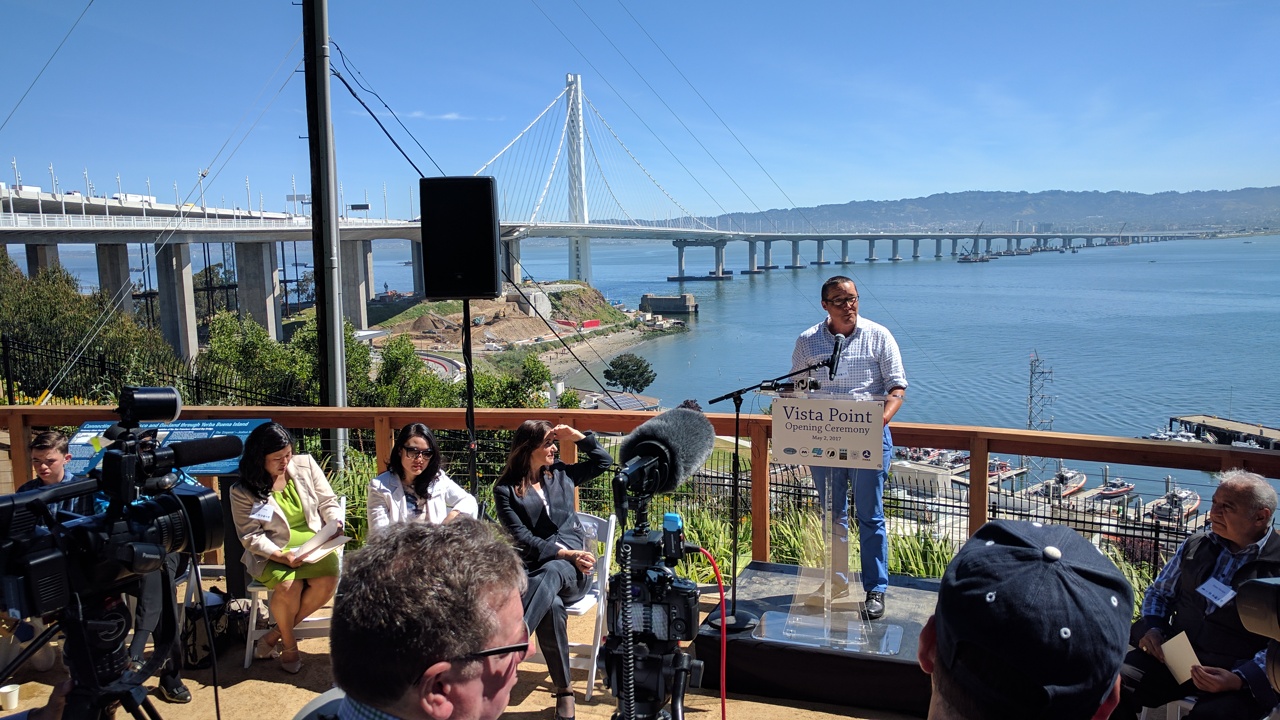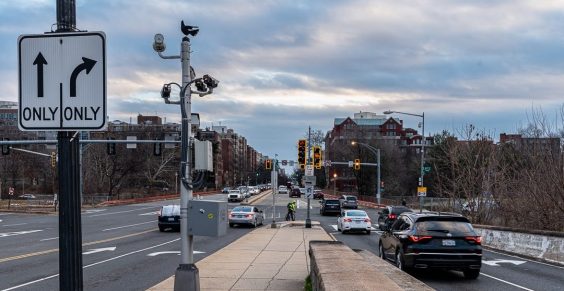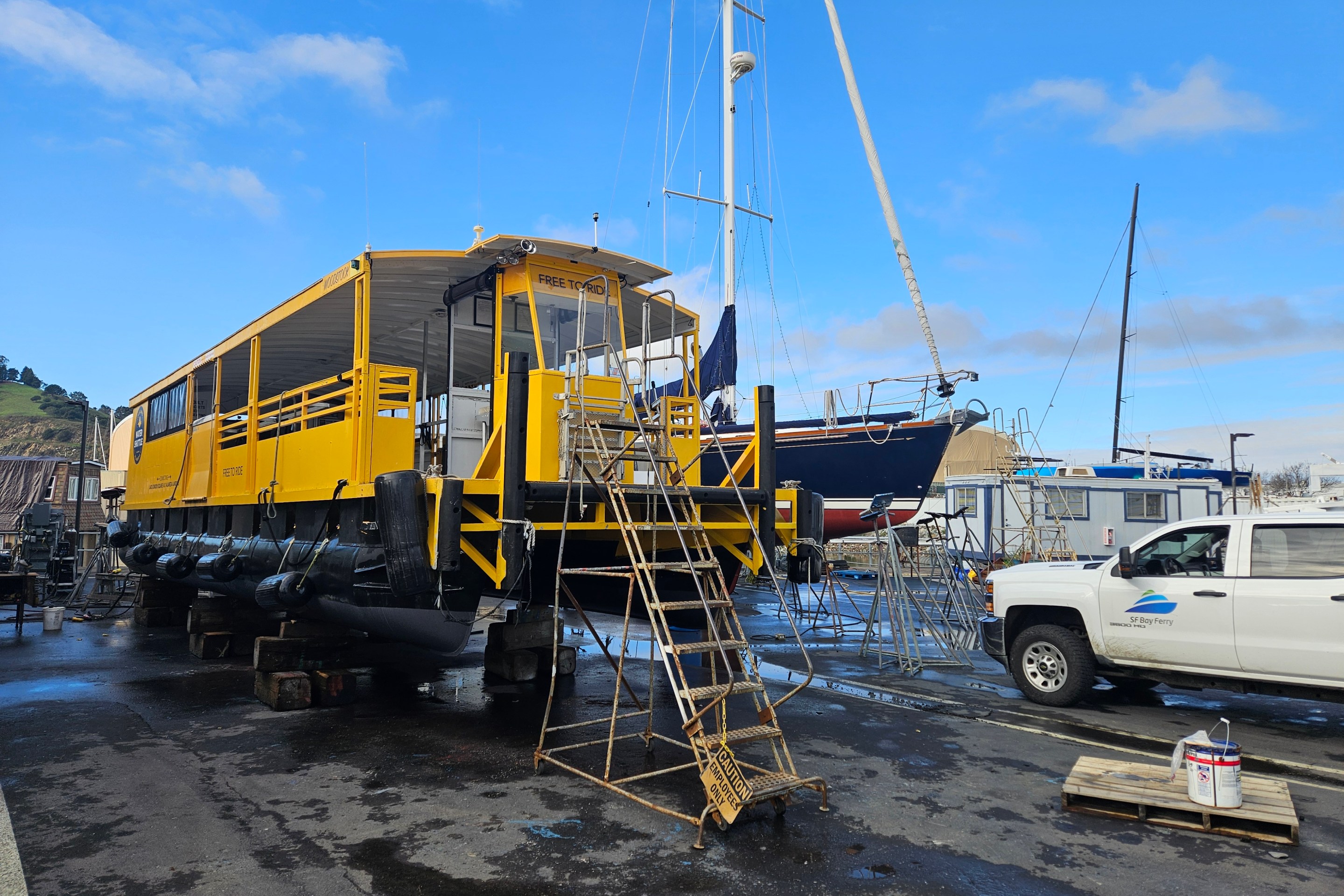Bike East Bay's Executive Director, René Rivera, will step down on May 1. The organization's communications director, Ginger Jui, will take over as interim ED, pending a search for a new full-time exec.
"This is a bittersweet decision because I have so much love for this organization and all the people who are a part of it," wrote Rivera in a statement. "At the same time, I am excited to take some time off to discover my next leadership challenge."
When Rivera started, seven years ago, the organization was "a scrappy band of bike advocates, then known as the East Bay Bicycle Coalition. In those days, it was just your Advocacy Director Dave Campbell and me working in a tiny back room of the Berkeley Bike Station," he wrote in his statement. The organization now has a real office in Jack London square and nine staffers. The annual budget has increased from $200,000 to just over $1 million this year.
Streetsblog sat down with Jui this afternoon at a coffee shop across from their office to talk about the organization's rapid growth, achievements in Oakland, Berkeley and elsewhere, and plans to maintain its trajectory as interim ED.
***
Streetsblog: The organization has really flourished during Rivera's tenure. How will you keep things moving?
GJ: My job is to keep the lights on, yes, but also to keep the bike advocacy moving full steam ahead. Number one thing is 'Bike to Work Day." I start on May 1 officially, and Bike to Work Day is May 10--that's the biggest thing.

SB: How many people participate in Bike to Work Day in the East Bay?
GJ: I don't have an exact number, but last year we gave away 20,000 Bike East Bay bags.
SB: That's a lot of bags. Anyway, usually I ask people about what events in their lives prompted them to get into advocating for safer streets. What was it for you? You studied biology, and yet somehow ended up at Bike East Bay. How did that happen?
GJ: I grew up riding bikes as a kid in the suburbs of LA, where it never seemed possible ride around as an adult. I got my license as soon as I could. But I went to college in Portland, Oregon, where I really started riding a bike for transportation. It was really easy there; there are well-paved streets, great neighborhood bikeways, and a really strong bike movement.
SB: But then you came back to California--
GJ: I went to Berkeley--
SB: For grad school?
GJ: Right. I moved here and suddenly I’m riding Telegraph on potholes and I’m thinking, oh no, what did I do!
SB: You realized right away you're not in Portland anymore.
GJ: I realized things could be better. I decided I need to make a difference so I joined what was then the East Bay Bicycle Coalition.
SB: Are you going to change the name back?
GJ: (laughs) No.
SB: Anyway, you went to study biology at UC Berkeley... what's the connection between biking and biology, aside from leg muscles?
GJ: The connection with biking is it’s really a great way to get out and ride some dirt roads and get out with nature. At Berkeley I knew things were coming to a head when I started scheming field projects about how I could load my bike to get to my fields. I was thinking more about biking than biology.
SB: So you like bike camping and getting out into nature. But how does that translate into advocating for urban cycling and safe streets?
GJ: I love taking my bike on the train and going to someplace close such as San Jose or Gilroy and riding my bike into Henry W. Coe State Park. Or going to Tahoe and the Sierras and riding trails. But with a bike the adventure starts from the moment you get on your bike outside your front door--there's no sitting in traffic, stuck on I-80 going to the mountains. With a bike, on a train, all of it is a vacation. None of it is driving.
SB: Okay. What is your vision for the future of bike infrastructure in the East Bay?
GJ: I want the East Bay to have a really great, dense, well-connected biking network. What that means is you don’t have to go more than two blocks to get on a safe, well-protected bikeway or a quiet neighborhood street to get you where you need to go. Say you have to go further, from Fremont to Hayward, or downtown Oakland to Berkeley--there should also be a really great regional trail that gets you to major networks.
SB: Including to Marin?
GJ: We’re really excited for the bike path to open on the Richmond-San Rafael Bridge, which will happen later this fall or early next year.
SB: What about the push back to make it an additional car lane during rush hour?
GJ: We’re going to make sure it is open 24-7 for bikes and pedestrians.
SB: And the Oakland Bay Bridge?
GJ: We're working with Caltrans to open the east end of the Bay Bridge 24-7. Right now there’s no overnight access.
SB: And getting it to San Francisco?
GJ: We're expecting the designs for what the pedestrian and biking path will look like later this summer, so we’ll get a really good look at it... the final design should be later this summer and we’re super excited.
SB: Protected bike lanes along Lake Merritt?
GJ: Along with Walk Oakland Bike Oakland, we pushed for protected bike lanes on Lakeside and Harrison.
SB: That was going to be another striped, door-zone lane before your intervention?
GJ: We pushed the city to upgrade the bike lanes to protected bike lanes. After construction started, the new Oakland Department of Transportation said, “Hey, we can do a lot better, we can put in landscaping that will look great and protect bicycles from traffic and add to making Lake Merritt into an urban jewel." Earlier this year Oakland DOT shopped the idea that we had added to their project... Bike East Bay got its members writing letters to the city council. We even got Children's Fairyland to give it the thumbs up--that's important because eventually it will turn a corner on Grand and extend to Children Fairyland.
SB: So that's how we get that protected bike network you described. I understand Harrison and Grand will be Oakland's first protected intersection.
GJ: It will. We’re seeing the start of a safe biking network right on that intersection. Protected bike lanes on Harrison and Grand are just the first piece. We're working on extending the Harrison Street protected bike lane to the BART station on 19th street.
SB: On the other parts of Lake Merritt--on Lake Merritt Boulevard and Lakeshore--there's just a striped gutter lane and no real bike facility, certainly nothing protected. Will Bike East Bay be willing to accept second-rate facilities such as that moving forward? Your counterparts in San Francisco said "no" to a door-zone bike lane on Turk Street.
GJ: I think SFBC is working on advocating for quality over quantity. And I agree with that. There are bike lanes in the East Bay that are really poor, such as one in Orinda that puts the bike lane between on-ramps, just as cars are merging--that's not a good situation to put anyone in. I think we should keep a "no card" in our pocket and keep our cities accountable for building the highest quality infrastructure.
SB: What city in the world would you most like to emulate, bike and transportation-wise?
GJ: My family is from Hong Kong. That experience of living in a city where transit is a no-brainer... you can get everywhere you want to go on a bus, a trolley, taxis, a train, soon high-speed rail too. Nobody except the super-rich have cars. I know the possibilities of what a city can look like if you don't expect to get in a private automobile when you first leave your house. At the same time, almost nobody bikes in Hong Kong. So my dream city has some combination of that, hyper-public transit infrastructure and a place that really prioritizes open space, and people getting around by bicycle. That's probably more adaptable to the layout of our American cities because there’s a lot more space to work with.
SB: So some of Hong Kong, some of Portland?
GJ: I want the East Bay solution. There are places we can emulate, but we need to find the local solutions to our transportation--solutions that really respect the communities of the East Bay.
SB: So are you applying to be permanent ED?
GJ: I expect to be interim for maybe three or four months as we’re doing the search for our next leader. Our board of directors has a search committee going so they’re doing a leadership evaluation to figure out our leadership needs and what kind of leader we’re looking for.
SB: Are you applying for permanent ED?
GJ: I can't comment.
SB: Anything else?
GJ: I think I want to talk about how great Bike East Bay Bay staff is. And I think it’s really important to give René a high five for developing an organization which is really not just about him, it’s really about us and all of our members.
SB: Thanks Ginger. And best of luck with the search!
GJ: Thanks.
This interview was edited.





